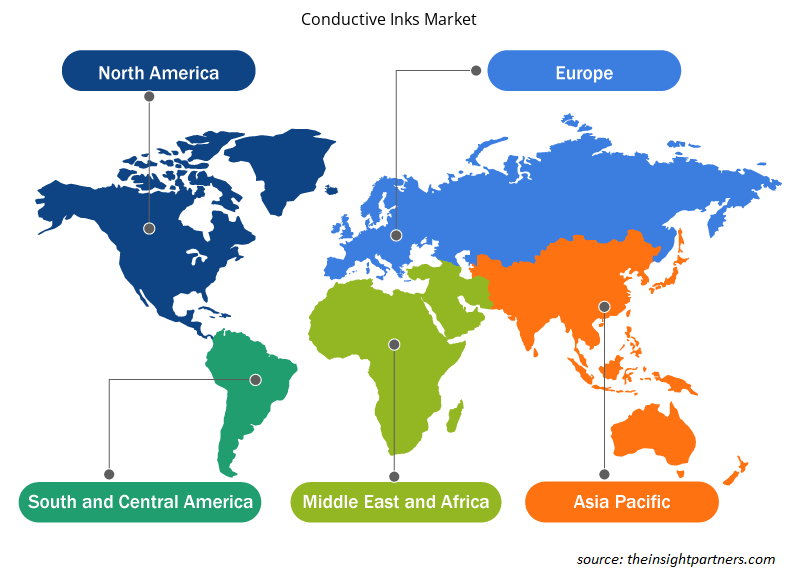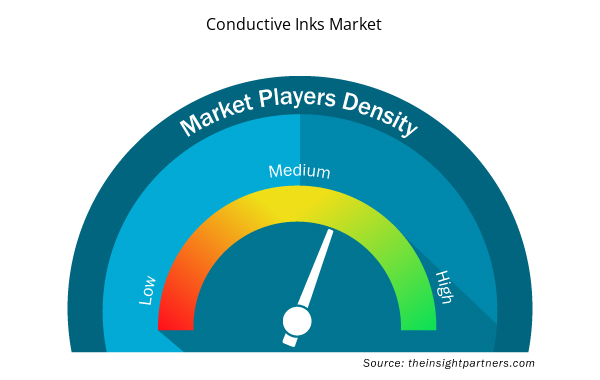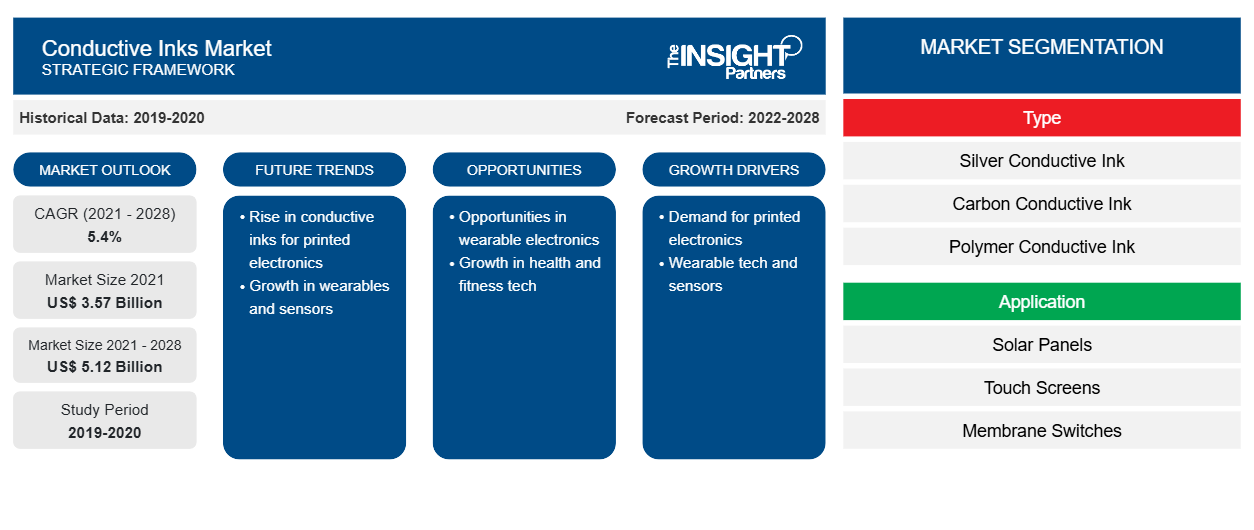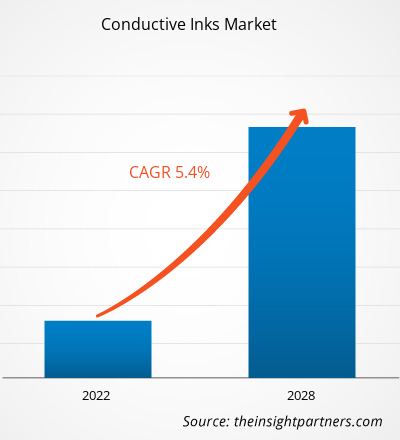[調査レポート] 導電性インク市場は、2021年の35億6,580万米ドルから2028年には51億1,980万米ドルに成長すると予想されており、2022年から2028年にかけて5.4%のCAGRで成長すると予測されています。
世界各国の政府は、業界がデバイスの重い材料を現代の軽量材料に置き換えることを奨励するために環境規制を制定しました。さらに、小型で軽量の電子機器に対する消費者の要望により、家電業界は製品の小型化を余儀なくされました。さらに、IoTベースのアプリケーションの急増と小型化の傾向の高まりにより、導電性インク市場の需要が促進されると予想されます。スマートフォン と接続デバイスの使用が急増しているため、低電力要件と強化されたパフォーマンスを備えたより小型で軽量のセンサーが必要になり、小型化の需要が刺激されています。中国は、世界の電子機器製造ビジネスのバリューチェーン全体を支配しており、小型電子製品を急速に作成するための新しい技術に多額の投資を行っています。したがって、スマートフォン、ウェアラブル、その他のガジェットの小型化の需要の高まりと効率的な電子機器の需要の増加により、導電性インクの市場 規模が拡大しています。
要件に合わせてレポートをカスタマイズする
このレポートの一部、国レベルの分析、Excelデータパックなど、あらゆるレポートを無料でカスタマイズできます。また、スタートアップや大学向けのお得なオファーや割引もご利用いただけます。
- このレポートの主要な市場動向を入手してください。この無料サンプルには、市場動向から見積もりや予測に至るまでのデータ分析が含まれます。
COVID-19パンデミックが導電性インク市場に与える影響
COVID-19パンデミックにより、多くのフレキシブルおよびプリンテッドエレクトロニクス業界は労働力不足に直面しました。現代の交通チケットに使用されるRFIDタグ印刷や自動車のフロントガラスデフロスターなど、プリンテッドエレクトロニクスアプリケーションにおける導電性インクの需要は、導電性インク市場の成長に貢献しています。さらに、自動車産業の生産減少も市場に悪影響を及ぼしています。国際自動車工業会(OICA)によると、2019年と2020年の世界の全車両販売台数はそれぞれ91,227,182台と78,774,320台でした。したがって、導電性インクは自動車の回路や、特に自動車のリアウィンドウの印刷デフロスターのアプリケーションに使用されているため、車両の販売減少は市場に悪影響を及ぼしています。ただし、2021年半ばからは、石油抽出プロジェクトの再開が導電性インク市場の成長を牽引しています。しかし、パンデミック以前は、北米の自動車産業の成長、電気自動車の普及率の上昇、健康に対する意識の高まりにより、デバイスの小型化の需要が促進されていました。消費者向け電子機器業界は成長を目の当たりにしてきました。また、スポーツウェアラブルウォッチや健康を監視する電子医療機器などの小型軽量電子機器の需要の高まりも、導電性インク市場の成長を後押ししています。
市場洞察 – 導電性インク市場
太陽光パネルの設置増加が導電性インク市場の成長を促進
エネルギー需要の増加により、代替エネルギー源の利用が必要になっています。その結果、再生可能エネルギー源、特に太陽エネルギーが現在、発電に使用されています。発電用の太陽エネルギーの採用の増加により、太陽光ベースの技術の需要が高まり、今後数年間でソーラーパネルの導入が増加すると予想されています。これにより、太陽光発電用途の導電性インク市場にチャンスが生まれます。インクジェット印刷を使用して、導電性インクは非常に薄く柔軟な表面に印刷された有機太陽光発電パネルを作成します。太陽光(光起電)部門は、既存のグリッド電力システムと競合するために、原材料コストを削減し、生産効率を高めるという大きなプレッシャーにさらされています。この場合、導電性インクは業界にとって潜在的なソリューションであり、導電性インク市場を牽引しています。
タイプベースの洞察
タイプに基づいて、導電性インク市場は、銀導電性インク、カーボン導電性インク、ポリマー導電性インク、銅導電性インク、その他に分類されます。カーボン導電性インクセグメントは、2021年に最大の市場シェアを占めました。カーボン導電性インクは潤滑性があり、摩擦が少なく、熱安定性に優れています。インクは、スクリーン印刷、ディッピング、シリンジディスペンシングに使用され、ガラスやその他のさまざまな基板との接着性に優れています。従来の導電性材料とは異なり、カーボンインクは摩耗、引っかき傷、屈曲、しわに耐性があります。導電性インクの開発は、プリンテッドエレクトロニクスセクターの急速な成長に支えられました。カーボンベースの導電性インクの導電性フィラーは、供給が広く、価格が安く、安定性が高く、アプリケーションの価値が高かった。Nanoshel LLC、Henkel、Dycotec Materials Ltdは、カーボン導電性インク市場の主要プレーヤーです。これらのプレーヤーの存在は、市場の成長に貢献しています。
導電性インク市場で活動する企業は、主に先進的で効率的な製品の開発に注力しています。
- 2022年、デュポンのマイクロサーキットおよびコンポーネントマテリアル事業は、ヘルスケア用途向けの新しい銀/塩化銀導電性インク/ペーストである5881の発売を発表しました。
- デュポンは2021年に、高性能電磁シールドおよび熱管理ソリューションの世界的リーダーであるレアード・パフォーマンス・マテリアルズの買収を完了したことを発表しました。
導電性インク市場の地域別分析
予測期間を通じて導電性インク市場に影響を与える地域的な傾向と要因は、Insight Partners のアナリストによって徹底的に説明されています。このセクションでは、北米、ヨーロッパ、アジア太平洋、中東およびアフリカ、南米および中米にわたる導電性インク市場のセグメントと地理についても説明します。

- 導電性インク市場の地域別データを入手
導電性インク市場レポートの範囲
| レポート属性 | 詳細 |
|---|---|
| 2021年の市場規模 | 35億7千万米ドル |
| 2028年までの市場規模 | 51億2千万米ドル |
| 世界のCAGR(2021年~2028年) | 5.4% |
| 履歴データ | 2019-2020 |
| 予測期間 | 2022-2028 |
| 対象セグメント | タイプ別
|
| 対象地域と国 | 北米
|
| 市場リーダーと主要企業プロフィール |
|
市場プレーヤーの密度:ビジネスダイナミクスへの影響を理解する
導電性インク市場は、消費者の嗜好の変化、技術の進歩、製品の利点に対する認識の高まりなどの要因により、エンドユーザーの需要が高まり、急速に成長しています。需要が高まるにつれて、企業は提供を拡大し、消費者のニーズを満たすために革新し、新たなトレンドを活用し、市場の成長をさらに促進しています。
市場プレーヤー密度とは、特定の市場または業界内で活動している企業または会社の分布を指します。これは、特定の市場スペースに、その市場規模または総市場価値に対してどれだけの競合相手 (市場プレーヤー) が存在するかを示します。
導電性インク市場で事業を展開している主要企業は次のとおりです。
- モレックス
- デュポン
- ヘンケルAG & Co. KGaA
- インクロン(ナガセグループ)
- インクテック
免責事項:上記の企業は、特定の順序でランク付けされていません。

- 導電性インク市場のトップキープレーヤーの概要を入手
導電性インク市場は、タイプと用途に基づいて分割されています。タイプに基づいて、市場は銀導電性インク、カーボン導電性インク、ポリマー導電性インク、銅導電性インク、その他に分類されています。2021年には、カーボン導電性インクセグメントが市場をリードし、最大の市場シェアを占めました。アプリケーションの観点から、市場はソーラーパネル、タッチスクリーン、メンブレンスイッチ、医療機器、プリント基板、センサー、加熱要素、無線周波数識別、携帯電話アンテナ、自動車などに分割されています。2021年には、プリント基板セグメントが市場をリードし、最大の市場シェアを占めました。地理的に、導電性インク市場は、北米、ヨーロッパ、アジア太平洋(APAC)、中東およびアフリカ(MEA)、南米(SAM)に広く分割されています。2021年には、APACが世界市場の大きなシェアを占めました。
導電性インク市場で事業を展開している大手企業としては、Applied Ink Solutions、DuPont DE Nemours、Inc.、Henkel AG and CO. KGAA、Inkron OY、Inktec、Heraeus、Novacentrix、POLY-INK、Merck KGAA、Vorbeck Materials Corporation などがあります。
- 過去2年間の分析、基準年、CAGRによる予測(7年間)
- PEST分析とSWOT分析
- 市場規模価値/数量 - 世界、地域、国
- 業界と競争環境
- Excel データセット



Report Coverage
Revenue forecast, Company Analysis, Industry landscape, Growth factors, and Trends

Segment Covered
This text is related
to segments covered.

Regional Scope
North America, Europe, Asia Pacific, Middle East & Africa, South & Central America

Country Scope
This text is related
to country scope.
よくある質問
The top five key players operating in the conductive inks markets Dupont de Nemours, Inc., Henkel AG & Co. KGaA, NovaCentrix, MERCK KGaA, and Heraeus Holding GmbH are among the key players profiled in the research study on the conductive inks market. The companies engage themselves in designing and developing conductive inks with competitive pricing which enables the manufacturers to attract customers, thereby, gaining market share
Based on application, the conductive inks market is segmented into solar panels, touch screens, membrane switches, medical devices, printed circuit boards, sensors, heating elements, radio frequency identification, cell phone antennas, automotive glass, etc. The printed circuit board segment accounted for the largest share in the conductive inks market in 2021. A printed circuit board is a rigid structure that contains an electrical circuit made of embedded metal wires called traces and larger areas of metal called planes. The high-performance conductive inks and adhesive materials can withstand high-temperature processing used in the manufacture of printed circuit boards and are contributing to the market growth.
Based on type, the conductive ink market is segmented into silver conductive ink, carbon conductive ink, polymer conductive ink, copper conductive ink, and others. The carbon conductive ink segment accounted for a larger share of the conductive ink market in 2021. Carbon conductive inks are lubricious, providing low friction and excellent thermal stability. The development of conductive inks was aided by the rapid growth of the printed electronics sector. Carbon-based conductive inks' conductive fillers had a wide supply, low price, good stability, and a lot of application value.
The rising adoption of conductive ink in various applications sectors such as 5G, automotive photovoltaic, power electronics, package-level EMI shielding, In-Mold Electronics, electronic textile and wearable electronics, skin patches, RFID, and others. The automotive industry has been a key target market for conductive ink manufacturers. Printed defrosters, particularly on rear windows, are a typical application. The use of transparent and efficient large-area heating to minimize apparent defroster lines is an important development. In Furthermore, seat heaters are also a notable market with ample upside growth opportunities.
The use of conductive inks in printing RFID chips has several advantages, such as reduced size and fast and efficient production, resulting in low production costs. In addition, the RFID tag's antenna is used to distribute frequency signals and establish a wireless link between the tag and the reader. Traditional antenna manufacturing methods are expensive and have slow production speeds. Also, they pollute the environment. To address these drawbacks, the technology of printing antennas with conductive ink is being used. Thus, the growing adoption of RFID technology drives the conductive inks market growth.
Trends and growth analysis reports related to Electronics and Semiconductor : READ MORE..
The List of Companies - Conductive Inks Market
- Molex
- DuPont
- Henkel AG & Co. KGaA
- Inkron (Nagase Group)
- InkTec
- Heraeus
- NovaCentrix
- Poly-Ink
- Merck KGaA
- Vorbeck Materials Corporation
The Insight Partners performs research in 4 major stages: Data Collection & Secondary Research, Primary Research, Data Analysis and Data Triangulation & Final Review.
- Data Collection and Secondary Research:
As a market research and consulting firm operating from a decade, we have published and advised several client across the globe. First step for any study will start with an assessment of currently available data and insights from existing reports. Further, historical and current market information is collected from Investor Presentations, Annual Reports, SEC Filings, etc., and other information related to company’s performance and market positioning are gathered from Paid Databases (Factiva, Hoovers, and Reuters) and various other publications available in public domain.
Several associations trade associates, technical forums, institutes, societies and organization are accessed to gain technical as well as market related insights through their publications such as research papers, blogs and press releases related to the studies are referred to get cues about the market. Further, white papers, journals, magazines, and other news articles published in last 3 years are scrutinized and analyzed to understand the current market trends.
- Primary Research:
The primarily interview analysis comprise of data obtained from industry participants interview and answers to survey questions gathered by in-house primary team.
For primary research, interviews are conducted with industry experts/CEOs/Marketing Managers/VPs/Subject Matter Experts from both demand and supply side to get a 360-degree view of the market. The primary team conducts several interviews based on the complexity of the markets to understand the various market trends and dynamics which makes research more credible and precise.
A typical research interview fulfils the following functions:
- Provides first-hand information on the market size, market trends, growth trends, competitive landscape, and outlook
- Validates and strengthens in-house secondary research findings
- Develops the analysis team’s expertise and market understanding
Primary research involves email interactions and telephone interviews for each market, category, segment, and sub-segment across geographies. The participants who typically take part in such a process include, but are not limited to:
- Industry participants: VPs, business development managers, market intelligence managers and national sales managers
- Outside experts: Valuation experts, research analysts and key opinion leaders specializing in the electronics and semiconductor industry.
Below is the breakup of our primary respondents by company, designation, and region:

Once we receive the confirmation from primary research sources or primary respondents, we finalize the base year market estimation and forecast the data as per the macroeconomic and microeconomic factors assessed during data collection.
- Data Analysis:
Once data is validated through both secondary as well as primary respondents, we finalize the market estimations by hypothesis formulation and factor analysis at regional and country level.
- Macro-Economic Factor Analysis:
We analyse macroeconomic indicators such the gross domestic product (GDP), increase in the demand for goods and services across industries, technological advancement, regional economic growth, governmental policies, the influence of COVID-19, PEST analysis, and other aspects. This analysis aids in setting benchmarks for various nations/regions and approximating market splits. Additionally, the general trend of the aforementioned components aid in determining the market's development possibilities.
- Country Level Data:
Various factors that are especially aligned to the country are taken into account to determine the market size for a certain area and country, including the presence of vendors, such as headquarters and offices, the country's GDP, demand patterns, and industry growth. To comprehend the market dynamics for the nation, a number of growth variables, inhibitors, application areas, and current market trends are researched. The aforementioned elements aid in determining the country's overall market's growth potential.
- Company Profile:
The “Table of Contents” is formulated by listing and analyzing more than 25 - 30 companies operating in the market ecosystem across geographies. However, we profile only 10 companies as a standard practice in our syndicate reports. These 10 companies comprise leading, emerging, and regional players. Nonetheless, our analysis is not restricted to the 10 listed companies, we also analyze other companies present in the market to develop a holistic view and understand the prevailing trends. The “Company Profiles” section in the report covers key facts, business description, products & services, financial information, SWOT analysis, and key developments. The financial information presented is extracted from the annual reports and official documents of the publicly listed companies. Upon collecting the information for the sections of respective companies, we verify them via various primary sources and then compile the data in respective company profiles. The company level information helps us in deriving the base number as well as in forecasting the market size.
- Developing Base Number:
Aggregation of sales statistics (2020-2022) and macro-economic factor, and other secondary and primary research insights are utilized to arrive at base number and related market shares for 2022. The data gaps are identified in this step and relevant market data is analyzed, collected from paid primary interviews or databases. On finalizing the base year market size, forecasts are developed on the basis of macro-economic, industry and market growth factors and company level analysis.
- Data Triangulation and Final Review:
The market findings and base year market size calculations are validated from supply as well as demand side. Demand side validations are based on macro-economic factor analysis and benchmarks for respective regions and countries. In case of supply side validations, revenues of major companies are estimated (in case not available) based on industry benchmark, approximate number of employees, product portfolio, and primary interviews revenues are gathered. Further revenue from target product/service segment is assessed to avoid overshooting of market statistics. In case of heavy deviations between supply and demand side values, all thes steps are repeated to achieve synchronization.
We follow an iterative model, wherein we share our research findings with Subject Matter Experts (SME’s) and Key Opinion Leaders (KOLs) until consensus view of the market is not formulated – this model negates any drastic deviation in the opinions of experts. Only validated and universally acceptable research findings are quoted in our reports.
We have important check points that we use to validate our research findings – which we call – data triangulation, where we validate the information, we generate from secondary sources with primary interviews and then we re-validate with our internal data bases and Subject matter experts. This comprehensive model enables us to deliver high quality, reliable data in shortest possible time.


 このレポートの無料サンプルを入手する
このレポートの無料サンプルを入手する